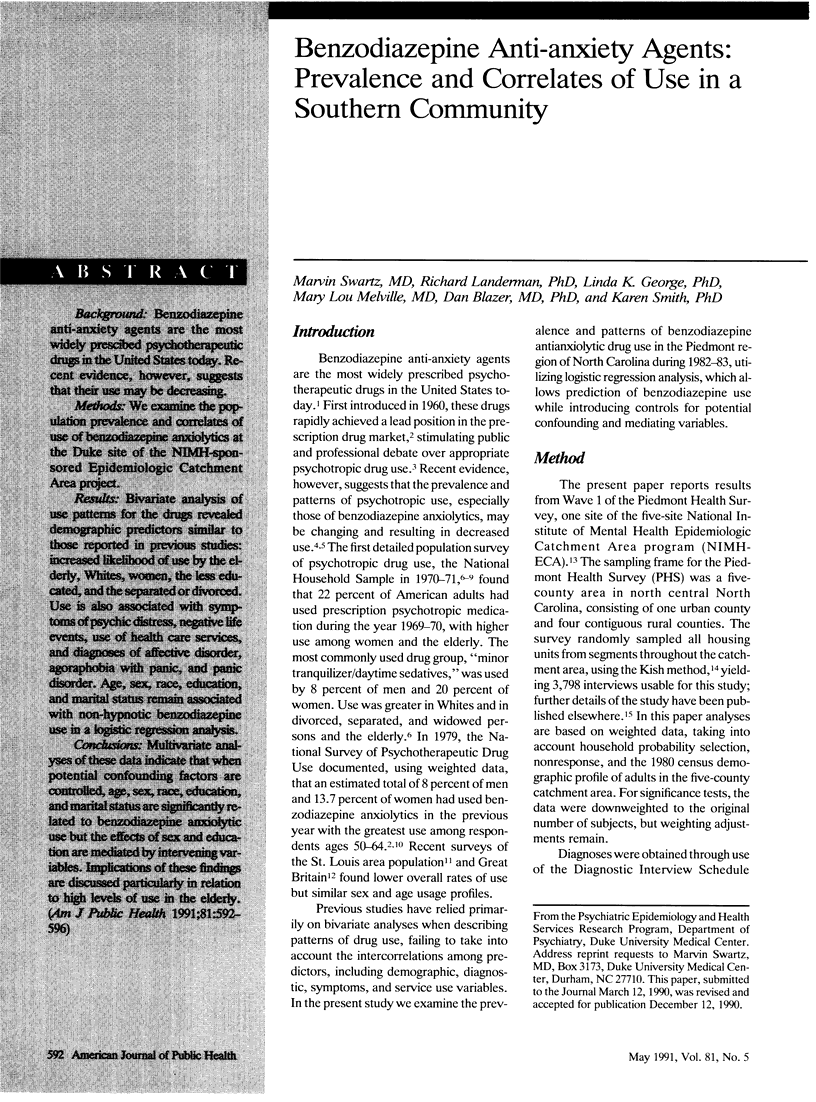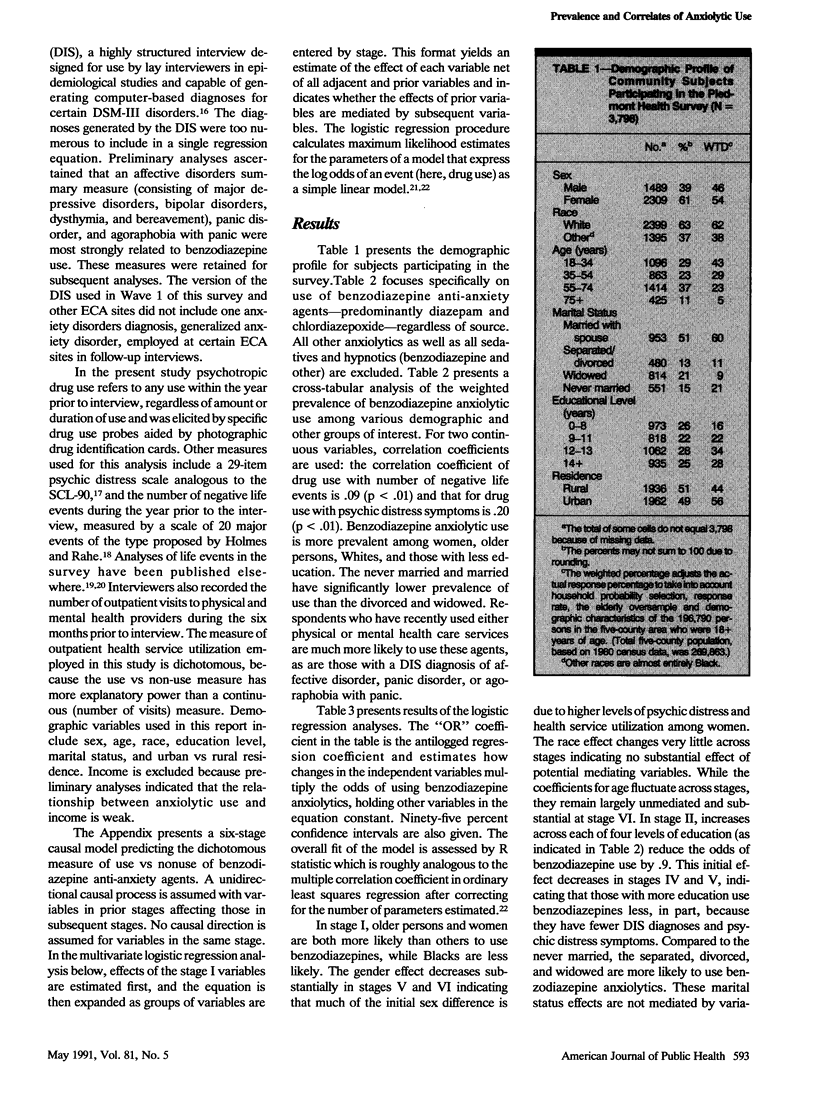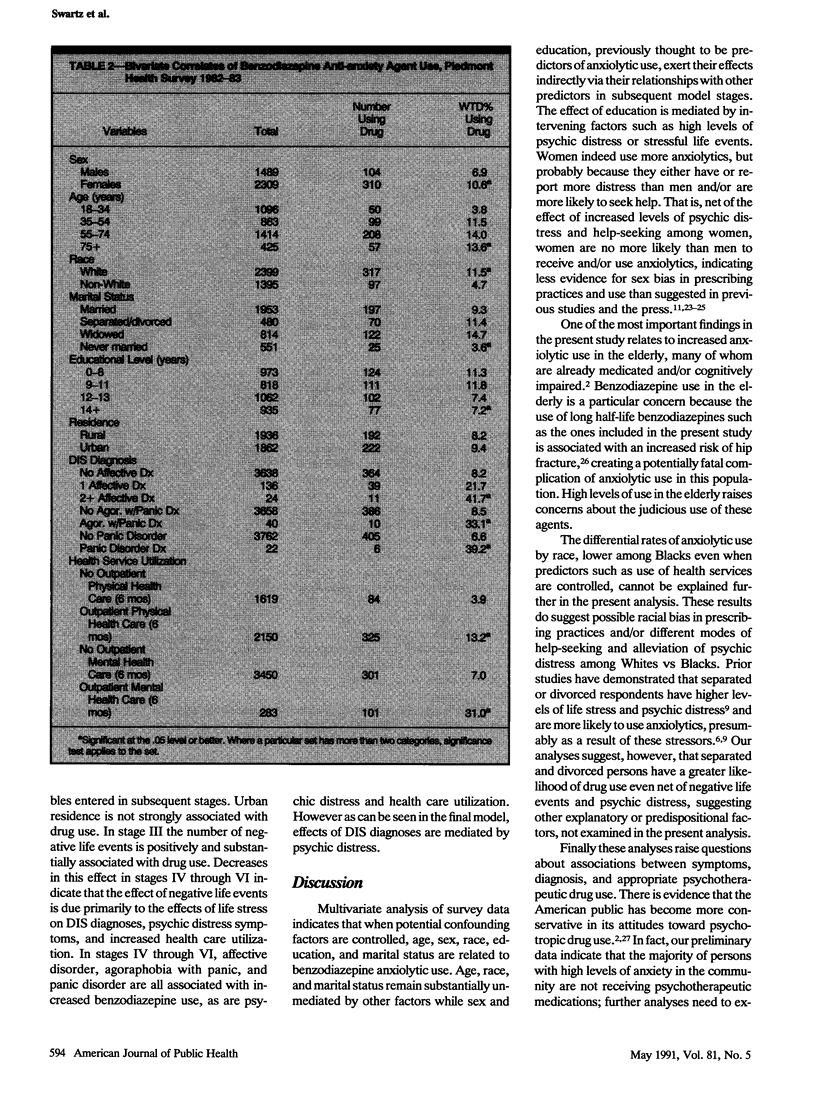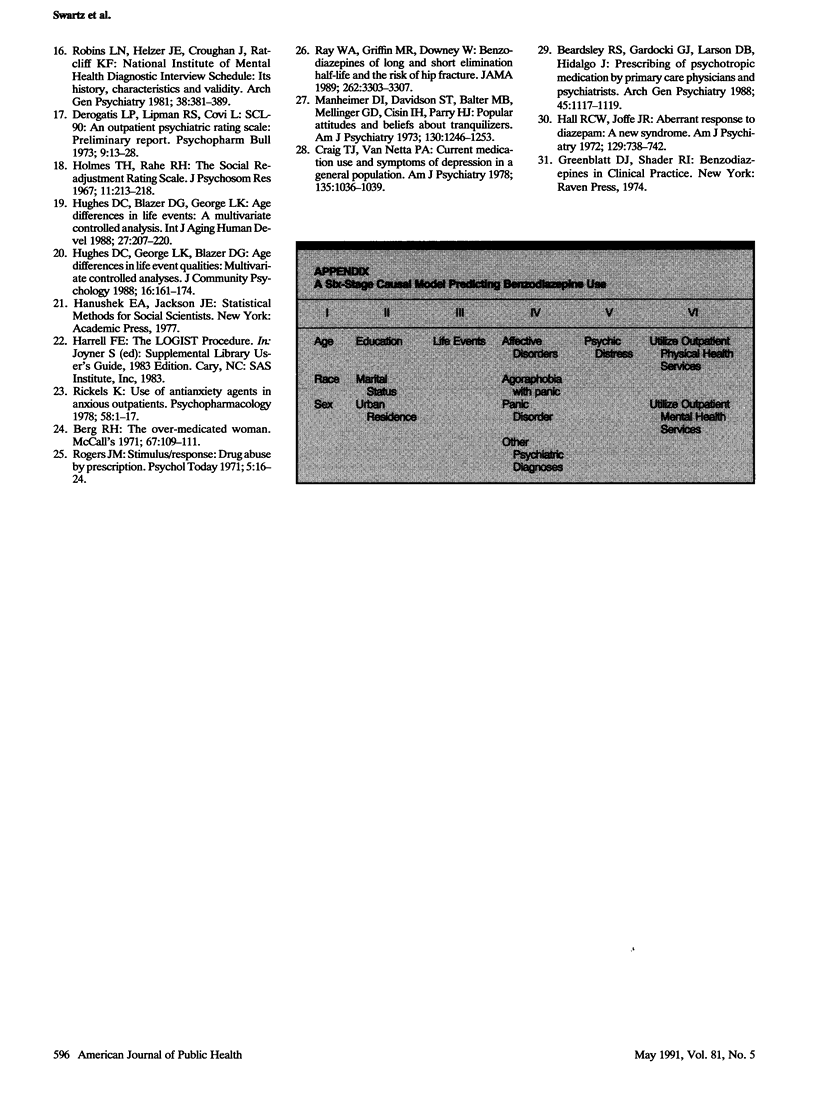Abstract
BACKGROUND: Benzodiazepine anti-anxiety agents are the most widely prescribed psychotherapeutic drugs in the United States today. Recent evidence, however, suggests that their use may be decreasing. METHODS: We examine the population prevalence and correlates of use of benzodiazepine anxiolytics at the Duke site of the NIMH-sponsored Epidemiologic Catchment Area project. RESULTS: Bivariate analysis of use patterns for the drugs revealed demographic predictors similar to those reported in previous studies: increased likelihood of use by the elderly, Whites, women, the less educated, and the separated or divorced. Use is also associated with symptoms of psychic distress, negative life events, use of health care services, and diagnoses of affective disorder, agoraphobia with panic, and panic disorder. Age, sex, race, education, and marital status remain associated with non-hypnotic benzodiazepine use in a logistic regression analysis. CONCLUSIONS: Multivariate analyses of these data indicate that when potential confounding factors are controlled, age, sex, race, education, and marital status are significantly related to benzodiazepine anxiolytic use but the effects of sex and education are mediated by intervening variables. Implications of these findings are discussed particularly in relation to high levels of use in the elderly.
Full text
PDF




Selected References
These references are in PubMed. This may not be the complete list of references from this article.
- Baum C., Kennedy D. L., Forbes M. B., Jones J. K. Drug use and expenditures in 1982. JAMA. 1985 Jan 18;253(3):382–386. [PubMed] [Google Scholar]
- Baum C., Kennedy D. L., Forbes M. B., Jones J. K. Drug use in the United States in 1981. JAMA. 1984 Mar 9;251(10):1293–1297. [PubMed] [Google Scholar]
- Beardsley R. S., Gardocki G. J., Larson D. B., Hidalgo J. Prescribing of psychotropic medication by primary care physicians and psychiatrists. Arch Gen Psychiatry. 1988 Dec;45(12):1117–1119. doi: 10.1001/archpsyc.1988.01800360065009. [DOI] [PubMed] [Google Scholar]
- Blazer D., George L. K., Landerman R., Pennybacker M., Melville M. L., Woodbury M., Manton K. G., Jordan K., Locke B. Psychiatric disorders. A rural/urban comparison. Arch Gen Psychiatry. 1985 Jul;42(7):651–656. doi: 10.1001/archpsyc.1985.01790300013002. [DOI] [PubMed] [Google Scholar]
- Craig T. J., Van Natta P. A. Current medication use and symptoms of depression in a general population. Am J Psychiatry. 1978 Sep;135(9):1036–1039. doi: 10.1176/ajp.135.9.1036. [DOI] [PubMed] [Google Scholar]
- Derogatis L. R., Lipman R. S., Covi L. SCL-90: an outpatient psychiatric rating scale--preliminary report. Psychopharmacol Bull. 1973 Jan;9(1):13–28. [PubMed] [Google Scholar]
- Dunbar G. C., Perera M. H., Jenner F. A. Patterns of benzodiazepine use in Great Britain as measured by a general population survey. Br J Psychiatry. 1989 Dec;155:836–841. doi: 10.1192/bjp.155.6.836. [DOI] [PubMed] [Google Scholar]
- Hall R. C., Joffe J. R. Aberrant response to diazepam: a new syndrome. Am J Psychiatry. 1972 Dec;129(6):738–742. doi: 10.1176/ajp.129.6.738. [DOI] [PubMed] [Google Scholar]
- Holmes T. H., Rahe R. H. The Social Readjustment Rating Scale. J Psychosom Res. 1967 Aug;11(2):213–218. doi: 10.1016/0022-3999(67)90010-4. [DOI] [PubMed] [Google Scholar]
- Hughes D. C., Blazer D. G., George L. K. Age differences in life events: a multivariate controlled analysis. Int J Aging Hum Dev. 1988;27(3):207–220. doi: 10.2190/F9RP-8V9D-CGH7-2F0N. [DOI] [PubMed] [Google Scholar]
- Manheimer D. I., Davidson S. T., Balter M. B., Mellinger G. D., Cisin I. H., Parry H. J. Popular attitudes and beliefs about tranquilizers. Am J Psychiatry. 1973 Nov;130(11):1246–1253. doi: 10.1176/ajp.130.11.1246. [DOI] [PubMed] [Google Scholar]
- Mellinger G. D., Balter M. B., Manheimer D. I., Cisin I. H., Parry H. J. Psychic distress, life crisis, and use of psychotherapeutic medications: national household survey data. Arch Gen Psychiatry. 1978 Sep;35(9):1045–1052. doi: 10.1001/archpsyc.1978.01770330019001. [DOI] [PubMed] [Google Scholar]
- Mellinger G. D., Balter M. B., Uhlenhuth E. H. Prevalence and correlates of the long-term regular use of anxiolytics. JAMA. 1984 Jan 20;251(3):375–379. [PubMed] [Google Scholar]
- Ray W. A., Griffin M. R., Downey W. Benzodiazepines of long and short elimination half-life and the risk of hip fracture. JAMA. 1989 Dec 15;262(23):3303–3307. [PubMed] [Google Scholar]
- Regier D. A., Myers J. K., Kramer M., Robins L. N., Blazer D. G., Hough R. L., Eaton W. W., Locke B. Z. The NIMH Epidemiologic Catchment Area program. Historical context, major objectives, and study population characteristics. Arch Gen Psychiatry. 1984 Oct;41(10):934–941. doi: 10.1001/archpsyc.1984.01790210016003. [DOI] [PubMed] [Google Scholar]
- Rickels K. Use of antianxiety agents in anxious outpatients. Psychopharmacology (Berl) 1978 Jun 15;58(1):1–17. doi: 10.1007/BF00426784. [DOI] [PubMed] [Google Scholar]
- Robins L. N., Helzer J. E., Croughan J., Ratcliff K. S. National Institute of Mental Health Diagnostic Interview Schedule. Its history, characteristics, and validity. Arch Gen Psychiatry. 1981 Apr;38(4):381–389. doi: 10.1001/archpsyc.1981.01780290015001. [DOI] [PubMed] [Google Scholar]
- Shader R. I., Greenblatt D. J. Benzodiazepine overuse-misuse. J Clin Psychopharmacol. 1984 Jun;4(3):123–124. [PubMed] [Google Scholar]
- Uhlenhuth E. H., Balter M. B., Lipman R. S. Minor tranquilizers: clinical correlates of use in an urban population. Arch Gen Psychiatry. 1978 May;35(5):650–655. doi: 10.1001/archpsyc.1978.01770290132013. [DOI] [PubMed] [Google Scholar]


